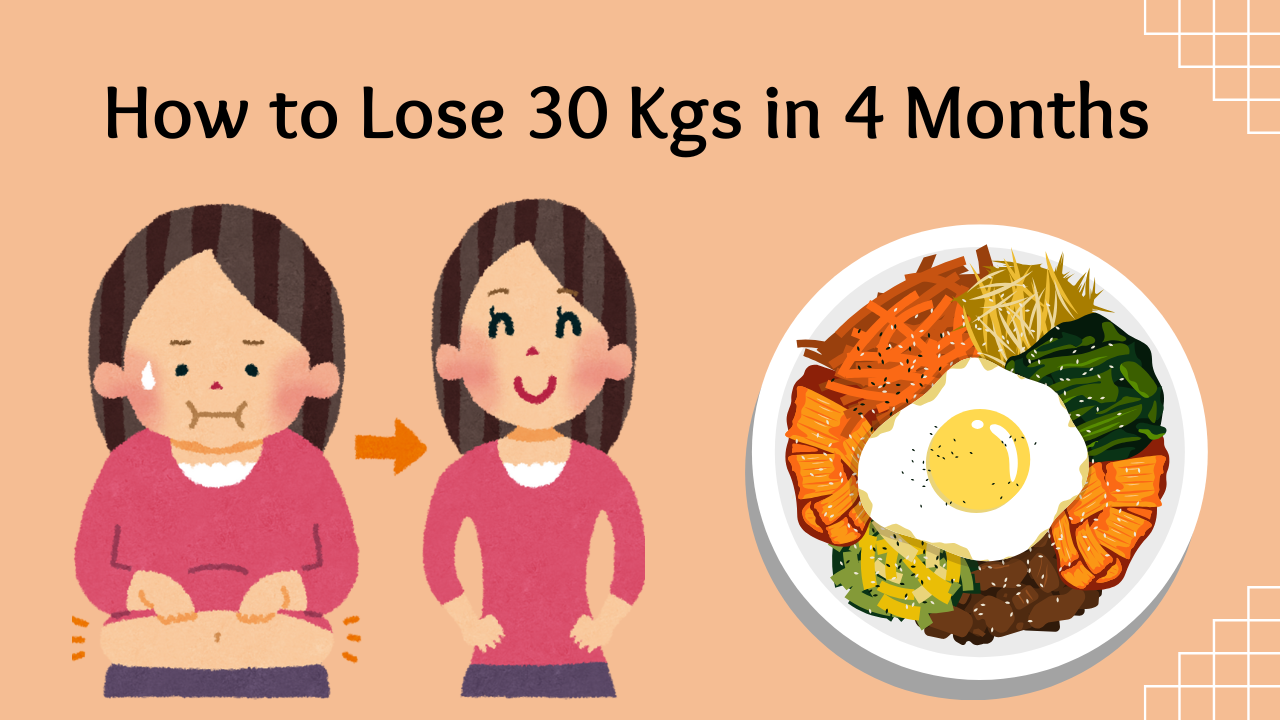Losing 30 kilograms in four months is a difficult yet reachable goal that requires discipline, planning and preparation, and unflinching commitment. The journey includes something just beyond consuming fewer calories but also about embracing a holistic approach where it incorporates nourishment, exercise, mindset, and way of overall lifestyle. This article gives expert, proof-based guidance to assist you with achieving this change securely and effectively.

Understanding the Goal
Losing 30 kilograms in four months is equal to shedding roughly 7.5 kilograms each month or around 1.9 kilograms each week. While this rate is somewhat over the regular suggestion of 0.5-1 kilogram each week, it’s achievable with a well-structured and balanced regimen that focuses on well-being and sustainability.
1. Set a Strong Foundation
Acknowledge Your Why
Start by identifying your motivation. Is it better health, increased energy, improved appearance, or enhanced self-confidence? Writing down your reasons will serve as a compass to guide you through the tough days.
Consult a Professional
Before embarking on this journey, consult with a healthcare professional or registered dietitian. They can assess your current health status, identify any underlying issues, and tailor recommendations to suit your specific needs.

Set Realistic Expectations
While aiming for rapid weight loss, understand that consistency and sustainability matter more than speed. Commit to a plan that prioritizes long-term results over quick fixes.
2. Master Nutrition
Caloric Deficit: The Key to Weight Loss
Weight loss occurs when you consume fewer calories than your body burns. Calculate your Total Daily Energy Expenditure (TDEE) and aim for a 500-1000 calorie deficit per day.

Focus on Macronutrients
- Protein: Consume 1.6-2.2 grams of protein per kilogram of body weight daily. Protein preserves muscle mass and enhances satiety. Include lean meats, eggs, dairy, legumes, and plant-based options.
- Carbohydrates: Opt for complex carbohydrates like whole grains, quinoa, and sweet potatoes. They provide sustained energy and prevent blood sugar spikes.
- Healthy Fats: Incorporate sources like avocados, nuts, seeds, and olive oil. Fats support hormone production and overall health.
Prioritize Nutrient-Rich Foods
Fill your plate with vegetables, fruits, whole grains, and lean proteins. These foods are high in nutrients and low in calories, making them ideal for weight loss.
Hydration Matters
Drink at least 2-3 liters of water daily. Proper hydration aids digestion, reduces hunger, and improves overall well-being

Plan and Prep Meals
Meal planning prevents impulsive eating. Prepare balanced meals in advance to stay on track with your goals.
3. Incorporate Physical Activity
Strength Training
Engage in strength training 3-4 times per week. Building muscle increases your resting metabolic rate, helping you burn more calories even at rest.
Cardiovascular Exercise
Combine high-intensity interval training (HIIT) with steady-state cardio. HIIT burns significant calories in a short time, while steady-state cardio builds endurance.
Active Lifestyle
Integrate more movement into your day: walk instead of driving short distances, take the stairs, or incorporate standing breaks during work.

4. Adopt a Growth Mindset
Track Your Progress
Regularly monitor your weight, measurements, and how your clothes fit. Celebrate non-scale victories, like increased energy and improved fitness levels.
Embrace Challenges
Understand that setbacks are part of the journey. Use them as opportunities to learn and grow rather than reasons to quit.
Practice Self-Compassion
Be kind to yourself. Avoid harsh self-criticism, and focus on progress rather than perfection.

5. Prioritize Sleep and Stress Management
Quality Sleep
Aim for 7-9 hours of sleep per night. Sleep regulates hunger hormones like ghrelin and leptin, reducing the likelihood of overeating.
Stress Management
Chronic stress can lead to emotional eating and weight gain. Practice mindfulness, meditation, or yoga to manage stress effectively.
6. Avoid Common Pitfalls
Crash Diets
Extremely low-calorie diets may yield rapid weight loss but often lead to muscle loss, nutrient deficiencies, and rebound weight gain.
Overtraining
Excessive exercise without adequate recovery can cause fatigue, injury, and burnout. Balance intensity with rest days to maximize results.
Unrealistic Comparisons
Avoid comparing your journey to others. Focus on your unique progress and celebrate small milestones.
7. Supplementation (If needed)
While most of your nutrients should come from whole foods, supplements like whey protein, omega-3 fatty acids, and multivitamins can support your goals. Always consult a professional before adding supplements to your regimen.

Sample Weekly Plan
Monday:
- Breakfast: Greek yogurt with berries and almonds
- Lunch: Grilled chicken salad with olive oil dressing
- Snack: Hard-boiled eggs
- Dinner: Baked salmon with quinoa and steamed broccoli
Tuesday:
- Breakfast: Scrambled eggs with spinach and whole-grain toast
- Lunch: Turkey and avocado wrap
- Snack: Apple slices with peanut butter
- Dinner: Stir-fried tofu with brown rice and mixed vegetables

Losing 30 kilograms in four months requires responsibility, consistency, and a mindful approach. While the process requires effort, the reward is useful: improved wellbeing, and renewed self-confidence. Keep in mind, that the way to progress lies in making habits that support your weight loss as well as your overall health. Seek out help when required, remain patient, and trust the process. This journey isn’t just about getting more fit — it’s tied in with acquiring a better, happier, healthier you.
